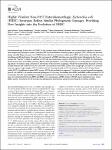Highly Virulent Non-O157 Enterohemorrhagic Escherichia coli (EHEC) Serotypes Reflect Similar Phylogenetic Lineages, Providing New Insights into the Evolution of EHEC
Eichhorn, Inga
Heidemanns, Katrin
Semmler, Torsten
Kinnemann, Bianca
Mellmann, Alexander
Harmsen, Dag
Anjum, Muna F.
Schmidt, Herbert
Fruth, Angelika
Valentin-Weigand, Peter
Heesemann, Jürgen
Suerbaum, Sebastian
Karch, Helge
Wieler, Lothar H.
Enterohemorrhagic Escherichia coli (EHEC) is the causative agent of bloody diarrhea and extraintestinal sequelae in humans, most importantly hemolytic-uremic syndrome (HUS) and thrombotic thrombocytopenic purpura (TTP). Besides the bacteriophage-encoded Shiga toxin gene (stx), EHEC harbors the locus of enterocyte effacement (LEE), which confers the ability to cause attaching and effacing lesions. Currently, the vast majority of EHEC infections are caused by strains belonging to five O serogroups (the “big five”), which, in addition to O157, the most important, comprise O26, O103, O111, and O145. We hypothesize that these four non-O157 EHEC serotypes differ in their phylogenies. To test this hypothesis, we used multilocus sequence typing (MLST) to analyze a large collection of 250 isolates of these four O serogroups, which were isolated from diseased as well as healthy humans and cattle between 1952 and 2009. The majority of the EHEC isolates of O serogroups O26 and O111 clustered into one sequence type complex, STC29. Isolates of O103 clustered mainly in STC20, and most isolates of O145 were found within STC32. In addition to these EHEC strains, STC29 also included stx-negative E. coli strains, termed atypical enteropathogenic E. coli (aEPEC), yet another intestinal pathogenic E. coli group. The finding that aEPEC and EHEC isolates of non-O157 O serogroups share the same phylogeny suggests an ongoing microevolutionary scenario in which the phage-encoded Shiga toxin gene stx is transferred between aEPEC and EHEC. As a consequence, aEPEC strains of STC29 can be regarded as post- or pre-EHEC isolates. Therefore, STC29 incorporates phylogenetic information useful for unraveling the evolution of EHEC.
Dateien zu dieser Publikation
Keine Lizenzangabe
Verwandte Publikationen
Anzeige der Publikationen mit ähnlichem Titel, Autor, Urheber und Thema.
-
2014-03-13ZeitschriftenartikelMortality and molecular epidemiology associated with extended-spectrum β-lactamase production in Escherichia coli from bloodstream infection Leistner, Rasmus; Sakellariou, Christian; Gürntke, Stephan; Kola, Axel; Steinmetz, Ivo; Kohler, Christian; Pfeifer, Yvonne; Eller, Christoph; Gastmeier, Petra; Schwab, FrankBackground: The rate of infections due to extended-spectrum β-lactamase (ESBL)-producing Escherichia coli is growing worldwide. These infections are suspected to be related to increased mortality. We aimed to estimate the ...
-
2017-11-13ZeitschriftenartikelRisk of Transmission of Antimicrobial Resistant Escherichia coli from Commercial Broiler and Free-Range Retail Chicken in India Hussain, Arif; Shaik, Sabiha; Ranjan, Amit; Nandanwar, Nishant; Tiwari, Sumeet K.; Majid, Mohammad; Baddam, Ramani; Qureshi, Insaf A.; Semmler, Torsten; Wieler, Lothar H.; Islam, Mohammad A.; Chakravortty, Dipshikha; Ahmed, NiyazMultidrug-resistant Escherichia coli infections are a growing public health concern. This study analyzed the possibility of contamination of commercial poultry meat (broiler and free-range) with pathogenic and or multi-resistant ...
-
2014-04-10ZeitschriftenartikelResults of surveillance for infections with Shiga toxinproducing Escherichia coli (STEC) of serotype O104:H4 after the large outbreak in Germany, July to December 2011 Frank, Christina; Milde-Busch, Astrid; Werber, DirkAfter the massive outbreak of infections with Shiga toxin-producing Escherichia coli (STEC) of serotype O104:H4 in Germany in the summer of 2011, post-outbreak surveillance for further infections with this type of STEC was ...

